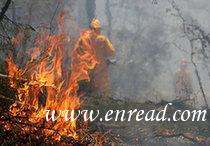澳大利亚南部维多利亚州和新南威尔士州2月7日起发生历史上最严重山火,至9日已经造成108人死亡,此次火灾也因此成为该国近几十年来造成人员伤亡最多的火灾之一。警方表示部分火灾可能是人为纵火,一旦查到真凶,将严惩不贷。此外,由于大风天气还在持续,估计还需要一些天的时间才能控制住火势。在此之前,澳大利亚最严重的森林大火发生在1983年,火灾导致75人死亡,维多利亚州和南澳大利亚州3000多座房屋被毁。

The deadliest wildfires in Australia's history burned people in their homes and cars and wiped out entire towns, officials discovered Sunday as they reached farther into the fire zone. The death toll1 rose to 108 by early Monday.
Blazes have been burning for weeks in the southeastern state of Victoria but turned deadly Saturday when searing temperatures and wind blasts created a firestorm that swept across a swath of the region. A long-running drought in the south — the worst in a century — had left forests extra dry and Saturday's fire conditions were said to be the worst ever in Australia.
From the air, the landscape was blackened as far as the eye could see. Entire forests were reduced to leafless, charred2 trunks, farmland to ashes. The Victoria Country Fire Service said some 850 square miles were burned out.
Only five houses were left standing3 out of about 40 in one neighborhood of the hard-hit Kinglake district that an Associated Press news crew flew over. Street after street was lined by smoldering4 wrecks5 of homes, roofs collapsed6 inward, iron roof sheets twisted from the heat. The burned-out hulks of cars dotted roads. A church was smoldering, only one wall with a giant cross etched in it remained standing.
All the deaths occurred in Victoria state, where at least 750 homes were destroyed.
Police said they suspect some of the fires were set deliberately7, and have declared some sites in the fire zone as crime scenes. If that is the case, Prime Minister Kevin Rudd said Monday, "there are no words to describe it other than mass murder."
On Sunday, temperatures in the area dropped to about 77 degrees but along with cooler conditions came wind changes that officials said could push fires in unpredictable directions.
Thousands of exhausted8 volunteer firefighters were battling about a dozen uncontrolled fires Monday in Victoria, officials said. But it would be days before they were brought under control, even if temperatures stayed down.
Residents were repeatedly advised on radio and television announcements to initiate9 their so-called "fire plan" — whether it be staying in their homes to battle the flames or to evacuate10 before the roads became too dangerous. But some of the deaths were people who were apparently11 caught by the fire as they fled in their cars or killed when charred tree limbs fell on their vehicles.
"It does appear that people have been taken by surprise by how fast this fire has come," Victoria police Sgt. Creina O'Grady told Australian Broadcasting Corp.
Police and fire officials reached on Sunday the town of Marysville and several hamlets in the Kinglake district, both about 50 miles north of Melbourne. They found the area utterly12 devastated13.
At Marysville, a picturesque14 hilly district that attracts hikers and tourists and is home to about 800 people, up to 90 percent of buildings were in ruins, witnesses said. Police said two people died there.
"Marysville is no more," Senior Constable15 Brian Cross told The Associated Press as he manned a checkpoint on a road leading into the town at Healesville.
At least 29 of the deaths were from the Kinglake area. Many residents in hard hit areas said the fires were moving so fast that they hit without warning, something that could have contributed to the unusually high death toll.
But so far officials said they were at a loss to explain why so many people have died. The sheer intensity16 of the firestorm Saturday may have caused panic among even veterans of wildfires.
Australia's worst fires before these were in 1983, when blazes killed 75 people and razed17 more than 3,000 homes in Victoria and South Australia state.
Wildfires are common during the Australian summer. Government research shows about half of the roughly 60,000 fires each year are deliberately lit or suspicious. Lightning and people using machinery18 near dry brush are other causes.
Dozens of fires were also burning in New South Wales state, where temperatures remained high for the third consecutive19 day. But there was no immediate20 threat to property.
 收听单词发音
收听单词发音 



